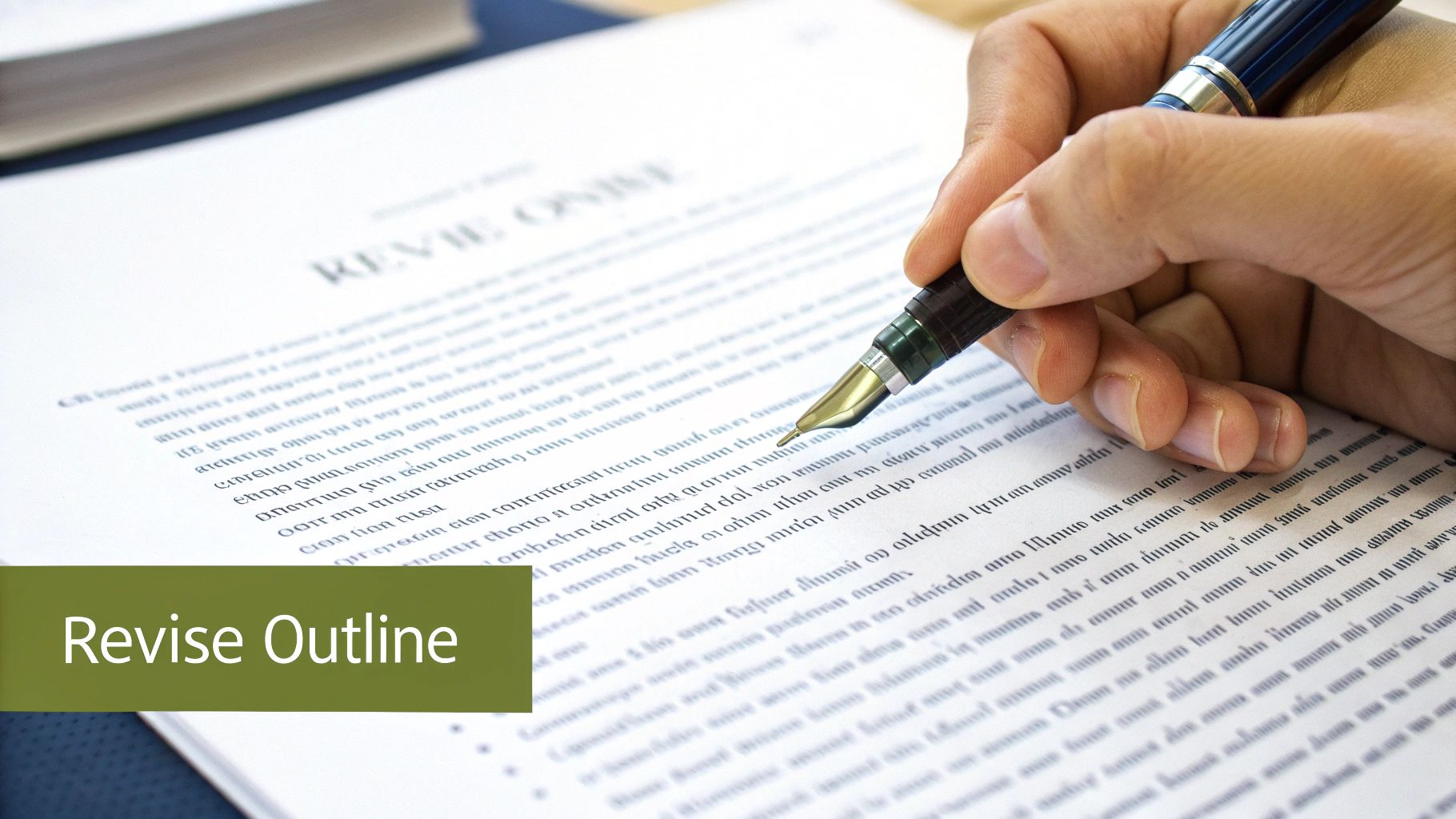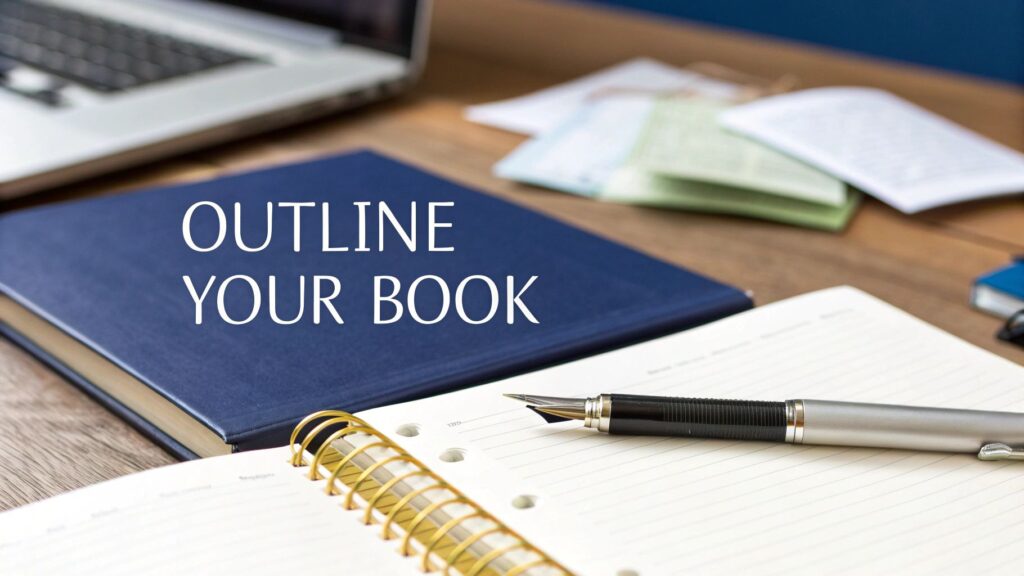So, you have an idea for a book. The first big step is to get that idea out of your head and onto paper in a structured way. This means defining your core concept, picking a narrative framework that works for you (like the classic three-act structure), and then mapping out the story beat-by-beat into scenes and chapters.
Think of this process as your roadmap. It's how you make sure your story flows logically and keeps a good pace before you dive into the marathon of writing the first draft.
Why an Outline is Every Writer's Secret Weapon
Before we get into the nitty-gritty of how to outline a book, let’s talk about why so many seasoned authors swear by it. If you're new to this, you might worry that a detailed plan will just box you in and kill your creativity. I get it. But in my experience, the opposite is almost always true.
An outline isn't a cage; it's more like a compass. It gives your story a clear direction, which actually frees you up to get creative with the fun stuff—like developing deep characters, writing sharp dialogue, and building a world your readers can get lost in—all without constantly worrying if the plot is going off the rails.
The Strategic Edge of Planning Ahead
A solid outline is your best defense against the most common pitfalls that trip writers up. It lets you spot and fix major problems when they're still just ideas on a page, which is a whole lot easier than trying to tear down and rebuild a chapter you've already spent weeks perfecting.
A good plan helps you sidestep issues like:
- Nagging Plot Holes: Those little gaps in logic or forgotten storylines that can pull a reader right out of the story.
- Wobbly Character Arcs: When a character's growth feels unnatural or their actions don't line up with who they are.
- The Dreaded 'Soggy Middle': We've all been there. It's that section where the story just…drifts. The momentum dies, and you're not sure where to go next.
By putting in the structural work upfront, you're saving yourself a ton of headaches and revision time later on. This isn't just a hunch, either. Market analysis shows that writers who outline are able to finish their manuscripts on time far more often—with a 35% higher completion rate than those who don't. If you're curious about industry trends, you can dig deeper into book publishing statistics on Straits Research.
An outline is a commitment to clarity. It’s the promise you make to yourself and your reader that the journey will have a purpose, every twist will have a reason, and the ending will feel earned.
At the end of the day, a well-thought-out outline gives you a rock-solid foundation. It’s the confidence boost you need to pour hundreds of hours into bringing your story to life, knowing the core of it is strong.
Outlining Your Book Before You Write
It's easy to see outlining as an extra, skippable step. But when you look at the common problems writers face, you realize it's not just a step—it's a solution.
| Problem Without an Outline | Solution With an Outline |
|---|---|
| Writing into a corner with no clear way forward. | A clear path from the inciting incident to the climax. |
| Characters lack clear motivation or goals. | Defined character arcs with purposeful development. |
| The second act drags and loses momentum. | Strategic placement of rising action and conflict. |
| Major plot holes discovered late in the draft. | Early identification and resolution of structural issues. |
Ultimately, taking the time to outline is a strategic move that pays off by making the entire writing process smoother and more focused.
Building Your Story's Foundation

A solid outline doesn’t just appear out of thin air. It starts with that first spark of an idea—the one you can't stop thinking about—and grows from there. This early stage is all about exploration, not rigid rules. It's where you take that initial flicker of inspiration and shape it into something you can actually build a story around.
The first real step is to pin down your central premise. What’s the single, core concept your story is built on? Are you writing a high-concept sci-fi thriller about memory implants, or is it a quieter, more literary novel exploring a long-held family secret? Let your mind wander and brainstorm freely. Don't edit yourself yet; just get it all down on paper.
From Big Idea to Sharp Logline
Once you've got a good grip on the premise, it's time to boil it down into a logline. This is your entire book, distilled into a single, punchy sentence. Think of it as the ultimate elevator pitch for your story.
A powerful logline usually contains three key ingredients:
- The protagonist
- Their main goal
- The conflict or antagonist standing in their way
Take Jurassic Park, for instance. A logline might be: "When a theme park's cloned dinosaurs break loose, a paleontologist must protect two children from prehistoric predators and find a way to escape the island." In just one sentence, you have the main character, the stakes, and the central conflict. It’s a blueprint for the entire plot.
Your logline is the ultimate test of your concept's clarity. If you can't summarize your story in one sentence, you might need to spend more time refining the core idea before moving forward.
This kind of foundational work isn't just for novelists. The principles of establishing a clear premise and structure are universal, which is why you'll see them echoed in general research paper writing tips as well.
Crafting Characters Who Drive the Story
With your premise locked in, you can turn your attention to the people who will bring this story to life. Your characters—especially your protagonist and antagonist—are the engine of your narrative. Their choices, desires, and flaws are what propel the plot forward.
Start by sketching out the basics. You don't need a ten-page biography at this point, just the core elements that will dictate their actions. For both your hero and your villain, ask yourself a few key questions:
- What is their ultimate goal? What do they want more than anything in the world?
- What is their core motivation? Why do they want it so badly? What drives them?
- What is their greatest fear? What are they terrified of losing or having to face?
- What is their critical flaw? What personal weakness constantly trips them up?
Picture a detective who desperately wants to solve a high-profile case (goal) because he needs to prove himself after a humiliating past failure (motivation). His greatest fear is being seen as washed-up and incompetent, and his flaw is a stubborn pride that prevents him from ever asking for help. Suddenly, you have a character with built-in, believable conflict.
When you know your characters this well, their actions start to feel inevitable. This groundwork is a crucial part of the overall https://barkerbooks.com/book-writing-process/ and makes the next steps of outlining feel much more natural. By figuring out who your characters are, you'll have a much better sense of what they would do in any situation.
Choosing the Right Outlining Method

There’s no one-size-fits-all approach to outlining. Just like every writer brings a unique voice to the page, the best outlining method is the one that aligns with how you think.
Some writers thrive on a detailed, linear plan, while others need the freedom of a more visual, brainstorming-style map. The real goal isn't to force yourself into a box; it's to find a structure that sparks clarity and makes you eager to start writing. Let’s look at a few popular methods that have helped countless authors get their ideas on the page.
The Synopsis Method
This one is a classic for a good reason. With the Synopsis Method, you simply write a short summary of each chapter before you even think about drafting. It's incredibly straightforward and perfect for writers who naturally think in a linear, A-to-B-to-C fashion.
You begin by sketching out your core beginning, middle, and end. Then, you break those big chunks down into individual chapters. For every chapter, you'll jot down a paragraph covering:
- What’s the main point or event that needs to happen?
- How does this chapter change your characters or what do they learn?
- What’s the hook at the end that pulls the reader into the next chapter?
This forces you to think about cause and effect from the get-go, making sure every part of your story has a purpose.
The Snowflake Method
Developed by author Randy Ingermanson, the Snowflake Method is designed for the writer who loves to build their story from a single seed of an idea and watch it grow. It’s an iterative process, expanding from one sentence into a full-blown, detailed outline.
Here's the basic flow:
- Start with a one-sentence summary. Think of it as your story’s elevator pitch.
- Flesh that sentence out into a paragraph that covers the initial setup, major conflicts, and how it all wraps up.
- Dive into your characters by writing a one-page summary for each major player.
- Map out your scenes in a spreadsheet, using just a single line to describe the action in each one.
This layered approach helps ensure your plot and characters are deeply woven together. If you want a deeper dive, our guide on https://barkerbooks.com/how-to-write-a-book-outline-that-truly-works/ breaks this down even further.
The Mind Map Method
Are you a visual thinker? Do you brainstorm with doodles and sticky notes? The Mind Map Method might be your new best friend. It’s a non-linear technique that’s brilliant for seeing the connections between your ideas.
Grab a big sheet of paper (or a digital canvas) and put your core story concept right in the center. From there, you just start branching out. Create arms for main characters, subplots, key settings, and major plot twists. Seeing different project outline example templates can also help you visualize how to structure your own unique story map.
An outline is more than just a plan; it's a diagnostic tool. It allows you to stress-test your story's logic, pacing, and character arcs before you invest hundreds of hours into the first draft.
This method is less about chronological order and more about understanding the relationships between all the moving parts of your book.
Don't be afraid to mix and match. Many writers borrow elements from different methods to create a hybrid system that works for them. The most important thing is finding a process that gets you excited and keeps you moving forward. Flexibility is your greatest asset.
Mapping Your Narrative from Beats to Scenes
Once you've settled on an outlining method that feels right, the real architectural work begins. This is where you translate those big, exciting ideas into a tangible, scene-by-scene roadmap for your entire story. You’re essentially building the skeleton of your novel, making sure every single moment has a purpose.
I like to think of this phase like a filmmaker storyboarding a movie. You start with the big, unmissable moments—the story beats—that define your narrative’s shape. These are the major turning points that hook the reader and give your story its drive. For a lot of writers, the classic three-act structure is a reliable blueprint for figuring out where these beats should go.
This visual flow shows how you can move from the big picture down to the nitty-gritty scenes that will make up your narrative.

Following this process ensures that every chapter and scene connects directly to the overarching plot. The end result is a much tighter, more cohesive story.
Pinpointing Your Essential Story Beats
Before you even think about chapters, you need to identify the pillars holding up your plot. These are the non-negotiable moments—the absolute must-haves—that define your story's beginning, middle, and end.
Key beats almost always include:
- The Inciting Incident: The catalytic event that yanks your protagonist out of their normal life and kicks off the real story.
- Rising Action: A series of escalating events, obstacles, and conflicts that build tension and push the character toward their ultimate confrontation.
- The Midpoint: A major turning point right in the middle. This is often a false victory or a devastating setback that completely changes the game.
- The Climax: The final, make-or-break showdown where the central conflict finally comes to a head.
- The Resolution: The aftermath. Here, you show the new normal for your characters and tie up any important loose ends.
By plotting these major milestones first, you create anchors for your timeline. You'll always know where your story needs to go, even if the path between those points is still a bit fuzzy. This high-level view is crucial.
Breaking Down Beats into Chapters and Scenes
With your major beats firmly in place, it’s time to zoom in. The next job is to break down the narrative space between these beats into individual chapters and, even more granularly, into scenes. A scene is the smallest unit of your story—a distinct moment of action and reaction that happens in a specific time and place.
For every single scene you plan, get in the habit of asking yourself three critical questions:
- What is the goal? What does the point-of-view character want to achieve in this scene?
- What is the conflict? What obstacle, whether internal or external, is stopping them?
- What is the outcome? Does the character succeed, fail, or get a mixed result? Crucially, how does this outcome change things?
Every scene must propel the story forward. If a scene doesn’t advance the plot, reveal crucial information, or deepen a character’s arc, it’s a prime candidate for the cutting room floor.
Let’s say a beat in your "Rising Action" is "The hero must find the hidden map." This one beat could easily break down into several scenes: questioning a reluctant informant in a seedy tavern, sneaking into a heavily guarded library at midnight, and finally, solving a cryptic riddle to reveal the map’s actual location.
Each of those scenes has a clear goal, a specific conflict, and an outcome that leads directly into the next. This kind of detailed planning is what keeps your narrative from stalling out.
Flesh Out Your Outline Before You Start Writing
You've built the skeleton of your story. Now, it’s time to add the muscle, sinew, and heart. This is the stage where your outline transforms from a simple blueprint into a vibrant, living guide that will make drafting feel less like a chore and more like you’re just filling in the blanks.
I like to think of this as leaving a detailed trail of breadcrumbs for my future self. For every key scene you've mapped out, you’re about to sprinkle in the kind of texture that ignites creativity when you finally sit down to write.
Add Emotional and Sensory Layers
This is where we move beyond the "what happens" of your plot. Under each scene or chapter summary, start dropping in the specific details that make a moment real. You're not writing the full scene yet—just quick, evocative notes.
Try adding a few bullet points for each scene:
- Character Emotions: What’s the emotional state of your protagonist when the scene opens? How has it shifted by the end? Be specific. "Starts hopeful, ends betrayed" is much more useful than just "sad."
- Sensory Details: What does the environment sound, smell, or feel like? Jot down a few powerful images. Think "the sharp scent of pine after a storm" or "the sticky floor of a dive bar."
- Key Dialogue: Is there one killer line of dialogue that absolutely has to be in this scene? Write it down now so you don't lose that perfect phrasing later.
- Subplot Connections: How does this scene push a secondary story forward? Make a quick note, like "This is where Sarah first notices the strange deliveries next door."
Think of stress-testing your outline as the final quality check before you dive into the draft. It’s your last, best chance to catch pacing issues, plug plot holes, and make sure your character’s journey feels both believable and completely earned.
Run a Final Stress Test
Before you pop the champagne and call the outline done, give it one last, critical read-through. This time, you're not just checking for completeness; you're looking for flow, logic, and impact.
Put on your editor's hat and ask yourself some hard questions:
- How's the Pacing? Do you have long, meandering sections with no real tension? On the flip side, are you bombarding the reader with non-stop, high-stakes action without a moment to breathe? Look for those lulls and frantic peaks.
- Any Glaring Plot Holes? Does a character suddenly know something they couldn't possibly know? Does a crucial event happen for no logical reason? It’s a million times easier to fix these gaps now than it will be after you’ve written 30,000 words.
- Is the Character Arc Solid? Look at your protagonist in the first chapter and then in the last. Is the transformation convincing? Trace their journey through the key plot points and make sure the change feels natural and hard-won.
This final polish is what lets you start drafting with total confidence. Once you're ready to get words on the page, you might want to check out some of the top writing tools for authors to boost creativity, since many of them are built to work perfectly with a detailed outline.
Common Questions About Outlining a Book

Even after laying out a step-by-step process, I know that sitting down to actually do the work brings up a whole new set of questions. It's only natural. Outlining is a deeply personal and creative act, so there's never going to be one single "right" way to do it.
My goal here isn't to give you rigid rules. Instead, I want to offer some practical advice for the most common hurdles writers face, based on years of seeing what works—and what doesn't. Let’s clear up some of that uncertainty.
How Detailed Should My Book Outline Be?
Honestly, this is the biggest "it depends" question of them all. The perfect level of detail is whatever helps you write most effectively. It’s a spectrum, and you need to find where you sit on it.
Some writers I know create incredibly granular, scene-by-scene outlines. They’ll map out snippets of dialogue, sensory details, and specific emotional beats for their characters before writing a single chapter. Others work best with a bare-bones "skeleton" outline—just the major turning points and a final destination, leaving almost everything else to discover as they go.
If you’re not sure where to start, try aiming for a chapter-by-chapter summary. For each chapter, just jot down its main purpose, the central conflict that needs to happen, and how it ends. That’s often enough to give you direction without feeling suffocated.
An outline is a roadmap, not a straitjacket. Its whole purpose is to guide you, not confine you. The second it stops feeling helpful, you have my full permission to change it.
What If My Story Changes While I Am Writing?
First off, don't panic. This is not only normal, it's a fantastic sign that your story is coming alive on the page.
Characters will develop minds of their own, a plot hole will reveal a much better twist, or a throwaway line will suddenly spark a brilliant new subplot. When this happens, welcome it. It’s part of the magic.
When your story does start to pull away from the plan, the best thing to do is pause the drafting for a bit. Go back to your outline and revise it to match the new direction your story is taking. A quick adjustment there can save you from writing hundreds of pages into a dead end, ensuring the new path actually connects with everything else you’ve built.
Can Writing Software Help Me Create an Outline?
Absolutely. The right tool can be a game-changer for organizing your thoughts and keeping everything straight when you outline a book. Many authors swear by them.
- Scrivener: This is a classic for a reason. Its digital corkboard lets you shuffle scenes around like index cards, making it incredibly easy to visualize and restructure your story.
- Plottr: As the name suggests, this one is built specifically for plotters. It offers visual timelines and templates based on popular story structures, which can be a huge help.
- Milanote: If you're a visual thinker, this is for you. It’s like an infinite digital whiteboard where you can create mood boards, mind maps, and character profiles, then link them all together.
That said, never underestimate the power of a simple Word doc, a fresh notebook, or a wall full of sticky notes. The best tool is the one that gets the ideas out of your head and onto the page.
At BarkerBooks, we know that a rock-solid outline is the foundation of every great book. Our expert editorial and ghostwriting teams partner with authors to sharpen their ideas, structure compelling narratives, and turn a brilliant plan into a globally published reality. Find out how we can support your writing journey at https://barkerbooks.com.
